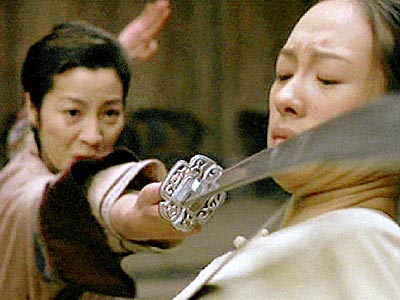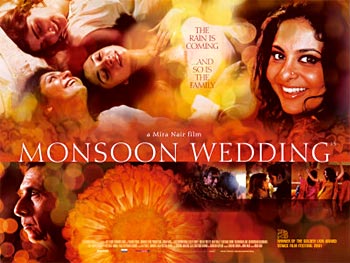
Of late every Bollywood producer wants to make the ultimate film, one that will crossover and become our own Crouching Tiger Hidden Dragon or Slumdog Millionaire. Both Slumdog and Crouching Tiger not only won critical acclaim but also became big money spinners in the West. So is it a quest for glory per se in the form of recognition in the West, or is it sheer size of the market for movies in the rest of the world that is driving these endeavors? The attempts so far have seen marginal to no success. Which brings to mind the questions - what is a crossover film and what content would make a successful crossover film?
Let me put forth my definition of a crossover film. Such films go beyond the traditional markets in the home country, or already exploited by films from the country, and usually end up making a lot of money. This is why no big studio film from HW is ever thought of as a crossover film - they have already expanded to the far reaches of the world, and depending on content, enjoy varying success in these regions. So why do we think of Slumdog Millionaire as a crossover film? Is it the fact that it is based on an Indian novel? Or the fact that it has a completely Indian cast? Can we think of Mel Gibson's Apocalypto as a crossover film? I would propose that Slumdog Millionaire was never intended to be, nor was it ever supposed to be a film that needed to crossover. It could be thought of as an Indie film that made it big, sort of like a mammoth Little Miss Sunshine.

What about Crouching Tiger Hidden Dragon? Ang Lee was coming off two successful Chinese films Wedding Banquet and Eat Drink Man Woman (both quite popular in the West) when he directed Sense and Sensibility. This one got him nominations and awards galore. As someone who went to film school in the US and trained under Spike Lee, it is not surprising that the man is in touch with Western audiences. So when he decided to make Crouching Tiger Hidden Dragon in the Wuxia genre with three strong female warriors, and a master who connected them together, he did not pick a traditional Chinese tale set way back in the past, but a rather contemporary tale set in the past, and used two actors who were not Chinese and already somewhat known in the west. Chow Yun-Fat was well known from the John Woo actions thrillers and has been seen in a few HW productions already, so this was favored over his inability to speak fluent Mandarin. Similarly Malaysian born Michelle Yeoh had already gained popularity as a Bond girl a few years before, and was picked despite her lack of Mandarin. So the film was made mainly for crossover audiences. It ended up being just that and not doing well at all in the home market in China. Similarly, the "Indian" (though never Bollywood) film Monsoon Wedding was a quintessential crossover film, that did poorly in the domestic market in India. Subjects that are acceptable to the Western audiences (like incest and pedophilia) will never be palatable to general Indian audiences outside a small niche of multiplex viewers.

Recent efforts in Bollywood to crossover also seem studied ones. The makers picked a demographic, and it had to be one that was fairly large, and then tried to fuse elements into their films that would entice that demographic. Thus Chandni Chowk to China filmed in China and used Chinese actors, had a martial arts focus, and even a leading lady who was supposed to be half-Chinese. The film fared poorly in the domestic market and created no blip in the Box office that caters to a billion Chinese speakers. Another similar example is that of Kites. In this film a Hispanic leading lady, a lot of Spanish dialogs, and a New Mexico and Mexico setting were used as hooks to lure in some fraction of the 400 million Spanish speakers worldwide. The film sank in the Indian market and left no mark anywhere else in the world. The third film had an Islamic focus, hoped to capture the fancy of some of over 1.5 billion Muslims population worldwide, and used an autistic man to showcase religious profiling in the US. The film was a decent success in the domestic market (though much less than one would expect for the scale at which it was mounted), and a bumper success in the Middle East, Malaysia, Singapore, all non-traditional markets with a substantial Muslim population. It fared well in the usual overseas markets and ended up as the highest overseas grossing BW film.

Before thinking of content that would work in crossover films, there are two points to consider. The first relates to the capacity in India itself. A film like 3 Idiots showed that with a crowd pleasing content it is possible to collect 2 times the money (in India) collected by any other Indian film. And when a film like this one does a decent job overseas (though in the traditional markets), one wonders why there is this fuss about crossing over. Second thing to keep in mind is that no film that was made with a deliberate aim to crossover ever succeeded on the home-ground. So success overseas, if seen at all, is usually at the expense of domestic success. While this has happened for some crossover films, with Crouching Tiger and Bend It Like Beckham as prime examples, when Indian film-makers stop making films for Indian audiences and chase after fame or money overseas they end up with NOTHING in their hands.

There is also the issue of Hollywood Studios trying to gain a foothold in the Indian market. Their investment aims to capitalize on the 1 billion plus Indian population, and is not focused on making a crossover film. They already have most of the Western market, and want to expand to non-traditional markets. Have they invested wisely so far? The investment of Sony Pictures in Saawariya was probably most suited to the goal the outfit was after, Saawariya was not supposed to be a crossover film. However, it turned into a debacle because no one ever saw what Mr. Bhansali was cooking until the dish was served up! And an adaptation of The White Nights, set in a fantasy land was not a film rooted in any tradition the Indian audiences could relate to. Warner Brothers invested in Roadside Romeo without realizing that a pricey children's film is a non-starter in India. We will go with our kids to see Harry Potter, but not some Indian made film that seems half baked. Now they are investing in more low key films, like Atithi Tum Kab Jaaoge, and meeting with good success. Fox invested in My Name is Khan and did not see much success in India, though the film saw excellent success in the Islamic world and in the traditional Hindi film markets overseas.
So what kind of films can crossover? Make films that tell stories that appeal to people world-over. Do not ape the West in narrative, or style. Be true to your roots and traditions.
Read more HERE
